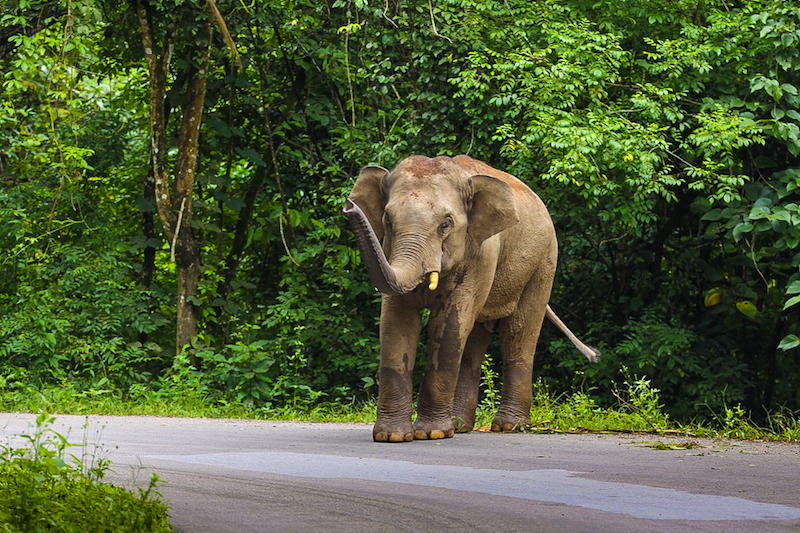If you’re looking for something to read in the six day count down to August 12th, enjoy World Elephant Day guest blogger Laurel Neme ‘s article on Human-Elephant Conflict, an issue often slightly less prominent in the public’s eye. Laurel describes in snapshots where humans and elephants clash and the resulting terrible consequences on both ends. She also highlights a number of strategies that can reduce those conflicts.
Oft-Forgotten Threat of Human-Elephant Conflicts
By Laurel Neme, Ph.D.
On World Elephant Day, people around the world come together to celebrate these pachyderms and raise awareness about the dangers they face. While poaching and the illegal ivory trade are often at the forefront of news stories, garnering less attention is the conflict between people and elephants.
The roots of conflict are complex. Elephants are being pushed onto smaller and smaller forest and land fragments as settlements expand and habitat is destroyed for other developments. The result is elephants and people sharing the same land—often with disastrous results.
Elephants eat a lot. A single adult can consume 200–600 pounds a day, which means the animals forage for most of the day—up to 18 hours. It comes as no surprise, then, that they eventually move onto farmers’ fields, where they trample and eat the crops. In a single night, a herd can destroy a family’s food for the year. Elephants pose a physical danger as well, sometimes killing or injuring people who try to shoo them away. It becomes a vicious cycle, with farmers and villagers retaliating by shooting or poisoning them, or even helping poachers.
Below are some snapshots of the impact and examples of how communities are trying to lessen the conflict.
Snapshots of the impact of human-elephant conflict:
- Tanzania’s Malinzanga, one of 23 agrarian villages outside Ruaha National Park, is a hot spot for crop raiding. There were almost 400 elephant raids there in 2016, and 100 more just in January 2017.
- Crop raiding by elephants in India affects 1 million hectares of land farmed by 1 million families. At times, that results in death to both elephants and people. According to the World Wildlife Fund, 100–300 people are killed by elephants each year in India, and 40–50 elephants die from conflicts.
- The situation is similar in Sri Lanka, where elephants kill about 50 people each year, and 100–150 elephants die from conflicts.
- Conflicts include train collisions and electrocution from low hanging power lines, both of which can kill elephants. Railway lines are a particular issue, as they often run through forests and other wildlife corridors for long distances.
- In India, trains killed 150 elephants between 1987 and 2010. In August 2016 in Sri Lanka, a passenger train killed an adult and three calves. In Kenya, a new railway links Mombasa to Nairobi, with almost 500 kilometers running through Tsavo Conservation Area. Conservationists remain concerned even though special passages for wildlife have been built and some sections are fenced off or elevated.
Solution Snapshots:
- Beehive fences — In Kenya and elsewhere in Africa and Asia, farmers hang beehives on wire fences to protect their plots. Studies show they are effective about 80 percent of the time. When an elephant disturbs the wire, it angers the bees. Because Elephants are afraid of being stung, they run away when they see or hear the beehives. The hives have an added benefit for farmers because they can sell the honey and earn extra income. One issue, however, is that despite their low-cost, they may still be beyond the reach of most farmers—which means building them can require outside funding from NGOs. In Tanzania, for example, the $900 cost of a beehive fence to protect two acres is almost twice what an average farmer can earn for the year.
- Chili peppers — Elephants don’t like chili Actually, what they hate is capsaicin, the chemical that makes them hot. Farmers take advantage of this natural deterrent and plant chilies around their crops or hang them on fences to create a “barrier” that elephants don’t want to cross. Others will burn chili briquettes or fire “chili guns” to deter the animals. Like the beehive fences, this option has the added benefit that farmers can earn extra income by selling the chilies.
- Early warning systems — Another strategy is for people to simply avoid the elephants. In India’s tea-growing region of Anamalai hills in Tamil Nadu, people are warned about elephants in an area so that they can avoid surprise encounters. A range of alert systems are used, including text messages, automated calls, announcements using public transport, and beacons in strategic locations.
- Herding drones — For the last two years, rangers in Tanzania have experimented with unmanned aerial vehicles (UAVs) to herd elephants away from farms and communities, according to a study published in Oryx. The quadcopter drones seem to work because the elephants dislike the buzzing sound. While some biologists fear the elephants will get used to the sound, so far, the rangers, who have flown over 120 flights, report no signs of decline in the drones’ efficacy, even with repeat-offender elephants who encounter the drones multiple times.
- Other strategies to reduce elephant deaths include: burying electric cables to stop electrocution of elephants by low-hanging wires; speed limits for trains; and special wildlife corridors or underpasses.
Laurel Neme is author of Animal Investigators: How the World’s First Wildlife Forensics Lab is Solving Crimes and Saving Endangered Species and Orangutan Houdini, and a regular contributor to National Geographic, Mongabay.com and The Revelator.
Download article here



